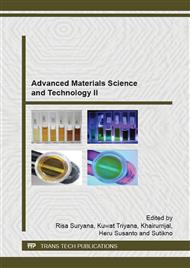[1]
Martuzzi, Marco, Francesco Mitis, and Francesco Forastiere, Inequalities environmental justice in waste management and health. The European Journal of Public Health (2010) 1-9.
DOI: 10.1093/eurpub/ckp216
Google Scholar
[2]
Francis, A. A., MK Abdel Rahman, and A. Daoud, Processing, structures and compressive properties of porous glass-ceramic composites prepared from secondary by-product materials. Ceramics International 39 (2013) 7089-7095.
DOI: 10.1016/j.ceramint.2013.02.048
Google Scholar
[3]
Chinnam, R. K., A. A. Francis, J. Will, E. Bernardo, and A. R. Boccaccini. Review. Functional glasses and glass-ceramics derived from iron rich waste and combination of industrial residues, Journal of Non-Crystalline Solids, 365 (2013): 63-74.
DOI: 10.1016/j.jnoncrysol.2012.12.006
Google Scholar
[4]
Bossert, J., E. Fidancevska, B. Mangutova, B. Panova, D. Milosevski, and M. Milosevski, Liquid phase sintering of dense and porous glass-ceramics from coal fly-ash and waste glass, Science of Sintering 36 (2004): 87-92.
DOI: 10.2298/sos0402087b
Google Scholar
[5]
Sulhadi, Khumaedi dan A. Yulianto, Aplikasi Proses Oksidasi untuk menentukan Potensi Daur Ulang Limbah Kaca (Cult), Semarang: Prosiding Pertemuan Ilmiah XXIV HFI Jateng & DIY, (2010).
Google Scholar
[6]
Sulhadi, M. I. Savitri, M. A Nur Said, I. Muklisin, R. Wicaksono dan M. A. Aji, Fabrication of Mesoporous Composite from Waste Glass and Its Use as a Water Filter, The 5th Nanoscience and Nanotechnology Symposium (NNS2013), (2013).
DOI: 10.1063/1.4866748
Google Scholar
[7]
Takei, Takahiro, Hiroaki Ota, Qiang Dong, Akira Miura, Yoshinori Yonesaki, Nobuhiro Kumada, and Hiroyuki Takahashi. Preparation of porous material from waste bottle glass by hydrothermal treatment. Ceramics International 38 (2012) 2153-2157.
DOI: 10.1016/j.ceramint.2011.10.057
Google Scholar
[8]
Walton, Krista S., and Randall Q. Snurr. Applicability of the BET method for determining surface areas of microporous metal-organic frameworks, Journal of the American Chemical Society 129 (2007) 8552-8556.
DOI: 10.1021/ja071174k
Google Scholar
[9]
Brun, Maurice, André Lallemand, Jean-François Quinson, and Charles Eyraud, A new method for the simultaneous determination of the size and shape of pores: the thermoporometry, Thermochimica acta 21 (1977) 59-88.
DOI: 10.1016/0040-6031(77)85122-8
Google Scholar
[10]
Colombo, Paolo, Cekdar Vakifahmetoglu, and Stefano Costacurta. Fabrication of ceramic components with hierarchical porosity, Journal of materials science 45 (2010) 5425-5455.
DOI: 10.1007/s10853-010-4708-9
Google Scholar
[11]
Eisma, D., P. Bernard, G. C. Cadee, V. Ittekkot, J. Kalf, R. Laane, Jo M. Martin, W. G. Mook, A. Van Put, and T. Schuhmacher, Suspended-matter particle size in some West-European estuaries; Part I: Particle-size distribution, Netherlands journal of sea research 28 (1991).
DOI: 10.1016/0077-7579(91)90017-u
Google Scholar


